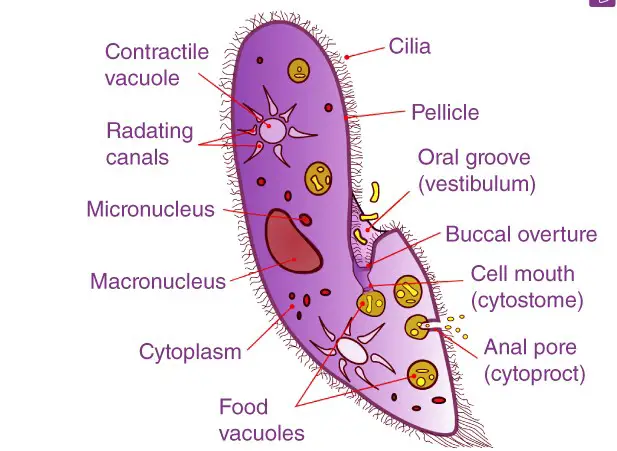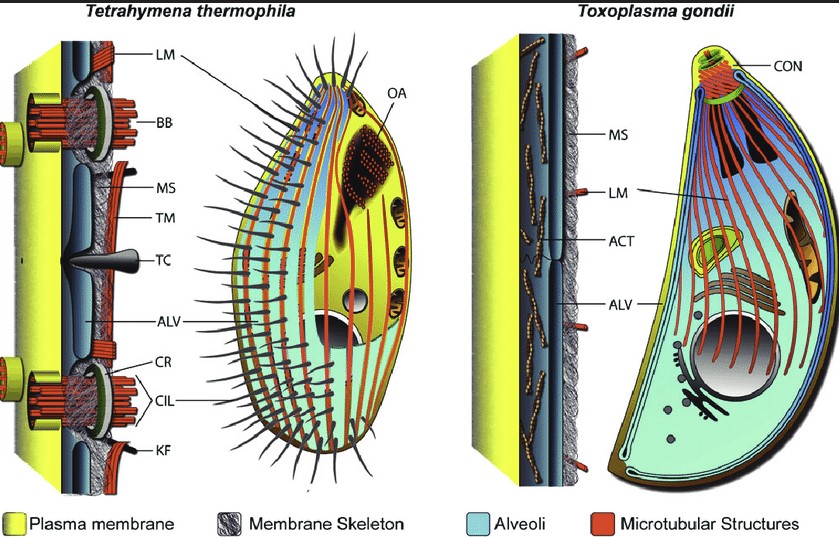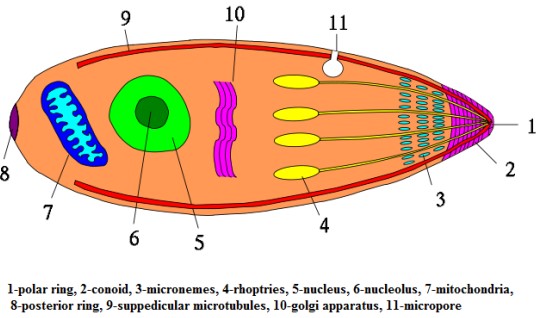Protozoa, a diverse group of single-celled organisms, are classified into several phyla, each with unique characteristics that distinguish them from others. Among these, Apicomplexa and Ciliophora stand out due to their distinct biological and ecological roles. These microorganisms play pivotal roles in both ecosystems and the health of other organisms, including humans. Their study offers valuable insights into the complexity of life at the microscopic level.
Apicomplexa are primarily known for their role as parasites, causing significant diseases in animals and humans, such as malaria. In contrast, Ciliophora, or ciliates, are characterized by their hair-like structures called cilia, which they use for movement and feeding. While both belong to the broader classification of protozoa, their differences in structure, life cycle, and impact on their surroundings are profound.
The distinction between Apicomplexa and Ciliophora lies in their morphology, reproduction strategies, and ecological roles. Apicomplexans are obligate parasites with complex life cycles often involving multiple hosts, while ciliates are free-living organisms that play essential roles in controlling bacterial populations and recycling nutrients. Understanding these differences not only sheds light on their individual contributions to biodiversity but also on their influence on human health and environmental stability.

Protozoa Classification
Protozoa, microscopic single-celled organisms, are as diverse as they are vital to both ecological systems and human health. They can be parasitic or free-living, thriving in a variety of environments from oceanic depths to the human body. Understanding their classification is key to unraveling the complexities of their existence and impact.
Key Characteristics of Protozoa
Protozoa are characterized by several features that distinguish them from other microorganisms:
- Eukaryotic: Unlike bacteria and archaea, protozoa have a well-defined nucleus and complex organelles, encapsulated within membranes.
- Mobility: Most protozoa can move, using structures like flagella, cilia, or pseudopods.
- Habitat Diversity: They inhabit water, soil, and living organisms, showcasing an incredible adaptability to environments.
- Reproduction: Protozoa reproduce using both asexual (binary fission, budding) and sexual (conjugation) methods, allowing for rapid population growth and genetic diversity.
Overview of Major Protozoan Phyla
The protozoan kingdom is divided into several phyla, each with unique characteristics:
- Apicomplexa: Parasitic organisms known for their complex life cycles and involvement in diseases like malaria.
- Ciliophora (Ciliates): Characterized by their cilia used for movement and feeding, playing crucial roles in aquatic ecosystems.
- Amoebozoa: Known for their ability to form pseudopods for movement and feeding.
- Euglenozoa: Includes both free-living and parasitic species, some of which are photosynthetic.
Apicomplexa Essentials
Apicomplexa are a phylum of intracellular parasites, notorious for their role in serious diseases affecting humans and other animals.
Defining Features
- Apical Complex: A unique set of organelles at one end of the cell, used for entering host cells.
- Complex Life Cycles: Often involve multiple hosts and stages, both sexual and asexual.
- Intracellular Parasitism: They live inside the cells of their hosts, a trait that makes them particularly dangerous pathogens.
Role in Ecosystems and Human Health
Apicomplexans have a profound impact on ecosystems by affecting the health and population dynamics of their hosts. In human health, they are known for causing diseases like malaria (Plasmodium spp.), toxoplasmosis (Toxoplasma gondii), and cryptosporidiosis (Cryptosporidium spp.).
Ciliophora Characteristics
Ciliophora, or ciliates, are a diverse group of protozoa known for their movement and feeding structures – the cilia.
Unique Traits
- Cilia: Short, hair-like structures covering their surface, used for locomotion and feeding.
- Two Types of Nuclei: Most have two nuclei (a large macronucleus and a small micronucleus), unique among protozoa.
- Complex Behavior: Capable of complex behaviors such as avoiding obstacles and hunting prey.
Ecological Significance
Ciliates are crucial for nutrient cycling and maintaining microbial populations in aquatic environments. They consume bacteria and other small organisms, reducing bacterial overgrowth and recycling nutrients back into the ecosystem.
Morphological Differences
The morphological distinctions between Apicomplexa and Ciliophora highlight their different lifestyles and ecological roles.
Cell Structure Comparison
- Apicomplexa: Characterized by the presence of the apical complex, a specialized structure for entering host cells. They lack external structures for movement, reflecting their parasitic lifestyle.
- Ciliophora: Covered in cilia, with complex internal structures like two types of nuclei, reflecting their free-living nature and need for complex behaviors.
Movement Mechanisms
- Apicomplexa: Do not have external structures for movement; their spread is closely tied to their host organisms and life cycle stages.
- Ciliophora: Use cilia for movement, allowing them to swim freely in search of food or escape predators.

Reproductive Strategies
The survival and propagation of protozoan species heavily depend on their reproductive strategies, which vary significantly between the phyla of Apicomplexa and Ciliophora. These strategies are finely tuned to their environments and life cycles, ensuring their success across diverse ecological niches.
Apicomplexa Reproduction
Apicomplexans have developed complex reproductive strategies that ensure their survival and dissemination through host populations. Their life cycles can be intricate, involving both asexual and sexual phases, often across different hosts.
- Asexual Reproduction: Often occurs within the intermediate host and involves the rapid multiplication of the parasite, leading to high infection rates.
- Sexual Reproduction: Typically takes place in the definitive host and is crucial for genetic diversity and the development of durable cysts or oocysts that can survive outside the host.
These strategies enable apicomplexans to exploit their hosts effectively, ensuring their spread and the continuation of their life cycle.
Ciliophora Reproduction
Ciliophora, or ciliates, employ both asexual and sexual reproduction, but their methods are notably different from those of the Apicomplexa.
- Binary Fission: The most common form of asexual reproduction among ciliates, where the cell divides into two identical daughters, ensuring rapid population growth.
- Conjugation: A form of sexual reproduction unique to ciliates, involving the exchange of genetic material between two cells. This process promotes genetic diversity, which is essential for adaptation and survival.
Ecological Roles
The ecological roles of Apicomplexa and Ciliophora are as diverse as their biological characteristics, influencing various aspects of their ecosystems.
Apicomplexa in Food Webs
Apicomplexa, primarily being parasites, play a complex role in food webs. They can significantly impact the population dynamics of their hosts, thereby influencing the structure of communities and ecosystems. For instance, by infecting a certain species, they can limit its population growth, potentially allowing for increased diversity by giving other species better chances to thrive.
Ciliophora’s Environmental Impact
Ciliophora significantly contribute to nutrient cycling and energy flow in aquatic ecosystems. They are key players in:
- Grazing on bacteria and other microorganisms, thus controlling microbial populations.
- Recycling nutrients, by breaking down and assimilating organic matter and then releasing inorganic nutrients back into the environment.
- Serving as prey for larger organisms, thus being integral to the food web.
Interaction with Humans
Both Apicomplexa and Ciliophora interact with humans, albeit in vastly different ways, from causing diseases to providing scientific insights and environmental benefits.
Apicomplexa: Parasitism and Diseases
The interaction between humans and Apicomplexa is predominantly negative due to the parasitic nature of these organisms. Diseases such as malaria, toxoplasmosis, and cryptosporidiosis have significant impacts on human health worldwide, leading to substantial morbidity and mortality.
- Malaria, caused by various species of Plasmodium, remains one of the deadliest diseases in tropical regions.
- Toxoplasmosis, while often asymptomatic in healthy individuals, can cause severe complications in immunocompromised patients and pregnant women.
- Cryptosporidiosis leads to severe gastrointestinal issues and can be life-threatening for individuals with weakened immune systems.
Ciliophora: Beneficial Uses
In contrast to Apicomplexa, Ciliophora often have a positive interaction with humans:
- Environmental Indicators: Their presence and diversity can indicate the health of aquatic ecosystems.
- Wastewater Treatment: Utilized in the degradation of organic material in sewage, contributing to water purification processes.
- Scientific Research: Serve as model organisms in genetic, ecological, and evolutionary studies, providing insights into cell biology and genetics.
Research and Studies
Significant research efforts have been directed towards understanding the biology, ecology, and impact of Apicomplexa and Ciliophora, with the aim of managing diseases and leveraging their ecological roles.
Key Studies on Apicomplexa
Research on Apicomplexa has primarily focused on understanding their life cycles, host-parasite interactions, and mechanisms of pathogenicity, with the goal of developing effective treatments and prevention strategies. For instance, the study of the Plasmodium genome has opened new avenues for malaria vaccine development and targeted drug therapies.
Significant Research on Ciliophora
Ciliates have been the subject of extensive research due to their complex cell biology and unique genetic processes. Studies on their genetic recombination, cellular differentiation, and behavioral responses have provided valuable insights into cellular mechanisms and evolutionary biology. Moreover, their role in aquatic ecosystems and bioremediation continues to be an area of active investigation.
Frequently Asked Questions
What makes Apicomplexa unique among protozoa?
Apicomplexa are unique because of their intricate life cycles and their role as obligate intracellular parasites. They possess specialized structures such as the apical complex, used for entering host cells. This phylum includes notorious pathogens like Plasmodium, which causes malaria, highlighting their significant impact on global health.
How do Ciliophora move and feed?
Ciliophora, or ciliates, use hair-like structures called cilia to move and feed. These cilia beat in coordinated patterns, propelling the organism through water and aiding in capturing prey. This mode of movement and feeding is unique to ciliates and distinguishes them from other protozoa.
What are the ecological roles of Apicomplexa and Ciliophora?
Apicomplexa mainly serve as parasites, impacting the populations of their hosts and, by extension, ecosystem dynamics. Ciliophora, on the other hand, play a crucial role in aquatic ecosystems by grazing on bacteria, thus controlling bacterial populations, and recycling nutrients, contributing to the health and stability of their environments.
How do Apicomplexa reproduce?
Apicomplexa reproduce through a complex life cycle that often involves both asexual and sexual phases and can require multiple hosts to complete. Their reproduction strategies are adapted to ensure survival and transmission between hosts, showcasing an intricate relationship with their environment and host organisms.
Conclusion
The distinctions between Apicomplexa and Ciliophora illuminate the incredible diversity of life at the microscopic level. These organisms, while small, have profound effects on their ecosystems and on human health. Their study not only enhances our understanding of biological diversity and ecosystem dynamics but also aids in the development of medical and environmental management strategies.
Understanding the differences between these two phyla underlines the importance of protozoa in ecological and health contexts. As we continue to explore the microscopic world, the knowledge gained from studying these organisms will undoubtedly contribute to advancements in science, medicine, and environmental conservation, highlighting the interconnectedness of all life forms.

